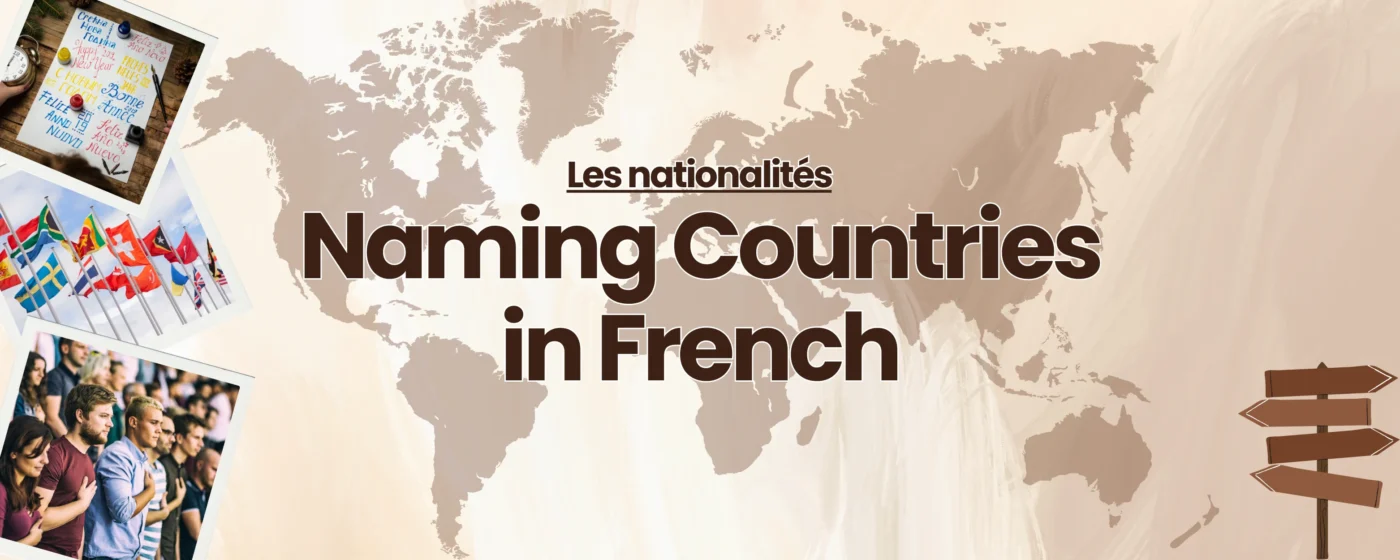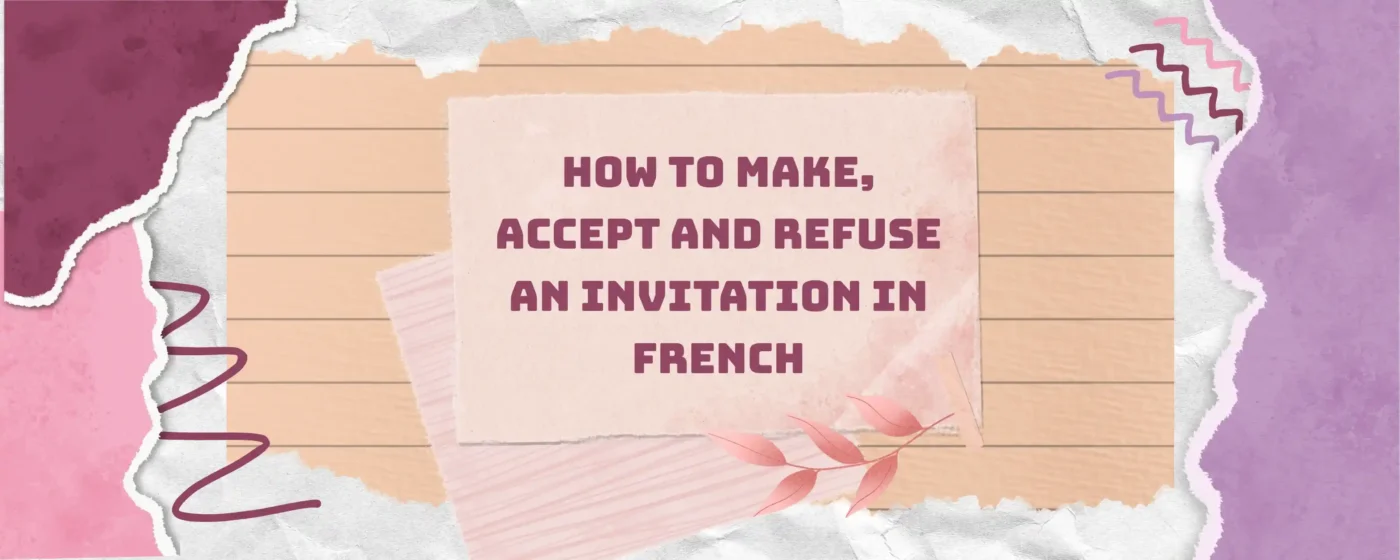Imagine trying to tell a new friend in France something like “I’m from India” without knowing your country or nationality name in French. Well, you’ll be stuck! Mastering these terms is key for natural daily conversations, navigating travel plans, and even truly engaging in cultural discussions. It’s not just about the country, though; French also has gender-based rules for nationalities! Let’s dive into this culturally fun but gender-specific world of nationalities and countries in French!
Names for Countries in French
In French, much like everything else, country names possess a gender. This means that they are either masculine or feminine, and sometimes plural. This differentiation is crucial because it helps you with the choice of definite articles (le, la, les) used with them. Misgendering a country can lead to incorrect sentence structure and must be avoided! How? Let’s have a look at some examples.
| Country Name | English Translation | Gender | Definite Article | Example |
|---|---|---|---|---|
| Le Canada | Canada | M | Le | Je vais au Canada. |
| Le Japon | Japan | M | Le | Il vient du Japon. |
| Le Brésil | Brazil | M | Le | Nous habitons au Brésil. |
| Le Mexique | Mexico | M | Le | Tu aimes le Mexique ? |
| La France | France | F | La | La France est belle. |
| La Chine | China | F | La | Elle voyage en Chine. |
| La Belgique | Belgium | F | La | La Belgique est petite. |
| La Russie | Russia | F | La | J’étudie en Russie. |
| L’ Allemagne | Germany | F | L’ | L’Allemagne est grande. |
| L’ Italie | Italy | F | L’ | Il parle italien en Italie. |
| L’ Espagne | Spain | F | L’ | L’Espagne est en Europe. |
| L’ Inde | India | F | L’ | Je rêve de visiter l’Inde. |
| L’ Iran | Iran | M | L’ | L’Iran est un pays ancien. |
| L’ Argentine | Argentina | F | L’ | L’Argentine est célèbre pour le tango. |
| Les États-Unis | The United States | Plural | Les | Les États-Unis sont grands. |
| Les Pays-Bas | The Netherlands | Plural | Les | J’adore les Pays-Bas. |
| Les Philippines | The Philippines | Plural | Les | Les Philippines ont de belles plages. |
As you have observed in the table provided above, each country name is accompanied by a definite article. But how do we decide which definite article goes with which country? Hmm, confusing? Not really; the choice of article depends on the gender and number of the country name, and whether it starts with a vowel or silent ‘h’. The final letters of a country name often help determine its gender: most country names ending in ‘-e’ are feminine, though there are exceptions.
Note: Some countries ending in ‘-e’ are actually masculine, such as le Mexique, le Cambodge, le Mozambique, and le Zimbabwe.
Here’s a breakdown:
- Le (masculine singular): Used before masculine country names that don’t start with a vowel.
- Example: le Canada
- La (feminine singular): Used before feminine country names that don’t start with a vowel.
- Example: la France
- L’ (masculine or feminine singular): Used before masculine or feminine country names that start with a vowel or silent ‘h’.
- Example: l’Iran (masculine), l’Allemagne (feminine)
- Les (plural): Used before plural country names (which often end in -s).
- Example: les États-Unis
Enhance your French with everyday terms from our blog on Places in a City: French Vocabulary for Daily Use.
Rules & Patterns
In French, nationality names are interesting because they can function as both adjectives and nouns. When referring to different nationalities in French, it’s important to consider context and tone to avoid unintended connotations. They must agree in gender and number with the person or people they describe. This means their endings change! But worry not, here’s a breakdown.
When used as an adjective, a nationality describes someone:
- Il est français. (He is French.)
- Elle est française. (She is French.)
- Ils sont français. (They [masculine/mixed] are French.)
- Elles sont françaises. (They [feminine] are French.)
Nationality adjectives are written in lower case, but when used as nouns to refer to people, they are capitalized.
Learning the correct feminine adjectives and masculine adjective forms is essential for proper usage and gender agreement.
When used as a noun, a nationality refers to a person from that country:
- C’est un Français. (He’s a Frenchman.)
- C’est une Française. (She’s a Frenchwoman.)
- Ce sont des Français. (They are French people [masculine/mixed].)
- Ce sont des Françaises. (They are French women.)
The way a nationality ends (for example, -ien, -ais, or a consonant) determines how the word changes for gender, so paying attention to the nationality ends is key. Correct pronunciation of nationality words is also important for clear communication.
How Endings Change?
The most common change to make a masculine nationality adjective or noun feminine is to add an -e. However, that’s not it!
- Adding -e (most common): If the masculine form ends in a consonant, you generally add an -e for the feminine. If it already ends in -e, it usually remains the same.
- Masculine: anglais (English), allemand (German), espagnol (Spanish)
- Feminine: anglaise (English), allemande (German), espagnole (Spanish)
- Doubling the final consonant and adding -e (for those ending in -n or -s): Many nationalities ending in -ien or -ais (among others) will double their final consonant before adding -e.
- Masculine: italien (Italian), canadien (Canadian), américain (American), japonais (Japanese)
- Feminine: italienne (Italian), canadienne (Canadian), américaine (American), japonaise (Japanese)
- No change (if masculine already ends in -e):
- Masculine: suisse (Swiss), russe (Russian), belge (Belgian)
- Feminine: suisse (Swiss), russe (Russian), belge (Belgian)
Common Patterns for Forming Nationalities
Here are a few examples of common patterns:
-ien → -ienne:
- Masculine: brésilien (Brazilian), indien (Indian), australien (Australian), vietnamien (Vietnamese), coréen (Korean)
- Feminine: brésilienne, indienne, australienne, vietnamienne, coréenne
-ais → -aise:
- Masculine: français (French), chinois (Chinese), portugais (Portuguese)
- Feminine: française, chinoise, portugaise
-ol → -ole:
- Masculine: espagnol (Spanish)
- Feminine: espagnole
-and → -ande:
- Masculine: allemand (German)
- Feminine: allemande
-ec → -eque:
- Masculine: grec (Greek)
- Feminine: grecque
Expand your vocabulary with essential French weather terms and idioms in this helpful guide on common expressions used daily.
List of Common Nationalities in French
Here’s a table of some of the most common nationalities in French, showing their masculine and feminine forms, and representing countries from each continent:
| Country | English Translation | Nationality (Masculine Singular) | Nationality (Feminine Singular) |
|---|---|---|---|
| France | France | Français | Française |
| Canada | Canada | Canadien | Canadienne |
| États-Unis | The United States | Américain | Américaine |
| Chine | China | Chinois | Chinoise |
| Japon | Japan | Japonais | Japonaise |
| Mexique | Mexico | Mexicain | Mexicaine |
| Brésil | Brazil | Brésilien | Brésilienne |
| Royaume-Uni | United Kingdom | Anglais | Anglaise |
| Allemagne | Germany | Allemand | Allemande |
| Espagne | Spain | Espagnol | Espagnole |
| Italie | Italy | Italien | Italienne |
| Russie | Russia | Russe | Russe |
| Inde | India | Indien | Indienne |
| Égypte | Egypt | Égyptien | Égyptienne |
| Maroc | Morocco | Marocain | Marocaine |
| Afrique du Sud | South Africa | Sud-Africain | Sud-Africaine |
| Australie | Australia | Australien | Australienne |
| Suisse | Switzerland | Suisse | Suisse |
To find more nationalities in French from any continent, you can use dictionaries or language resources.
How to Use Nationalities in Sentences?
To introduce yourself or someone else using nationalities in French, the verb être (to be) is your best-friend! You use the adjective form of the nationality, making sure it agrees in gender with the subject.
Examples:
- Je suis canadien. (I am Canadian – Masculine)
- Je suis canadienne. (I am Canadian – Feminine)
- Il est allemand. (He is German.)
- Elle est allemande. (She is German.)
- Nous sommes français. (We are French – Mixed group of both males and females)
- Elles sont françaises. (They are French – All females)
In French, the names of languages (la langue) are usually derived from the masculine adjective form of the nationality. For example, ‘le français’ comes from the masculine adjective ‘français’, and ‘anglais’ (English) from ‘anglais’. Although ‘langue’ (language) is feminine, the names of languages themselves are masculine and not capitalized. These language names are used in both written and spoken French.
However, this is not the only way! For expressing origin, you can also use venir de (to come from).
Examples:
- Je viens du Canada. (I come from Canada.)
- Elle vient d’Allemagne. (She comes from Germany.)
Stop Guessing, Start Speaking!
With our expert tutors, you’ll master the words you need to speak French confidently!
Mistakes to Avoid When Using Nationalities
Remember to watch out for 2 common errors while using nationalities in French: gender mismatch (Example: Elle est ‘française’, not ‘français’) and capitalization. It’s crucial to remember that nationalities are always in the lowercase when describing someone (Example: Il est français) but in the uppercase when they are the person (Example: C’est un Français). Pay attention to these 2 errors and you’re sorted!
ChatGPT said:
Enhance your language skills by exploring essential terms in this helpful guide on French Transportation Vocabulary for everyday use.
Learn More with La Forêt French Classes
Had fun discovering this topic? Well, there’s much more you can explore with our team of experts and resources that will take away those worries about the language! You can visit La Forêt French Class for structured French courses, language tests, training resources, and many others, as well as some insightful blogs and articles related to the language. Happy learning!
Frequently Asked Questions
1. Are there any countries that don’t use a definite article (le, la, les) before their name in French?
Ans: Certainly! While most countries require an article to accompany them, there are quite a few that fly solo, especially islands or city-states. Some common examples are Cuba, Israël, Malte, Haïti, Monaco, Singapour, Djibouti, Oman, Bahreïn.
2. How can I tell if a country ending in ‘-e’ is masculine or feminine?
Ans: Well this is a confusing one. While most feminine nouns end in ‘-e’, several common masculine countries also end in ‘-e’. Preposterous, right? Well, there’s no strict rule, so these often need to be memorized. Major examples are: le Mexique, le Cambodge, le Mozambique, le Zimbabwe.





